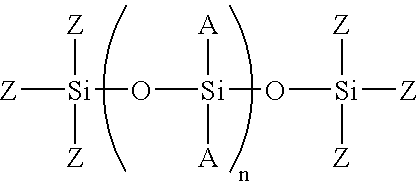Composite coating for imparting particle erosion resistance
a technology of composite coating and particle erosion resistance, which is applied in the field of coating compositions, can solve the problems of increased downtime, shortened service life, and increased maintenance costs, and achieve the effect of improving strength and resistance to abrasion
- Summary
- Abstract
- Description
- Claims
- Application Information
AI Technical Summary
Benefits of technology
Problems solved by technology
Method used
Image
Examples
example 1
[0043] A coating composition was prepared by combining 30 parts of a linear siloxane, silanol terminated poly dimethylsiloxane having a molecular weight of 110,000, with 57 parts of a solvent, xylene. To this 5.4 parts of a poly(Bisphenol A-co-epichlorohydrin) glycidyl end-capped component, Epon 1001-X-75 was added and thoroughly mixed. Hard particles in the form of hexamethyldisilazane treated fume silica were added at the level of 3.2 parts. To the resulting mixture, 0.068 parts of a catalyst, dibutyltin dilaurate was added. This was combined with 2 parts of a silsesquioxane former, ethyl triacetoxysilane. The mixture was allowed to stand approximately 15 minutes, and 2.6 parts of an active hydrogen compound, Epicure 3164, believed to be a polyamine, was added. The resulting composition was applied to test specimens and allowed to cure at ambient temperature and humidity for 7 days before testing.
example 2
[0044] A coating composition was prepared by combining 25 parts of a linear siloxane, silanol terminated poly dimethylsiloxane having a molecular weight of 110,000, with 49 parts of a solvent, xylene. To this 4.6 parts of a poly(Bisphenol A-co-epichlorohydrin) glycidyl end-capped component, Epon 1001 X-75 was added and thoroughly mixed. Hard particles in the form of hexamethyldisilazane treated fume silica were added at the level of 2.8 parts. To the resulting mixture, 0.0585 parts of a catalyst, dibutyltin dilaurate was added. This was combined with 1.74 parts of a silsesquioxane former, ethyl triacetoxysilane. The mixture was allowed to stand approximately 15 minutes, and 13.9 parts of hard particles in the form of thoroughly dried titanium carbide powder was added. An active hydrogen compound, Epicure 3164, believed to be a polyamine, was added in 2.2 parts and the mixture was thoroughly mixed.
example 3
[0045] A coating composition was prepared by combining 34 parts of a linear siloxane, silanol terminated poly dimethylsiloxane having a molecular weight of 110,000, with 33 parts of a solvent, xylene. Hard particles in the form of Cab-o-sil TS610 treated fume silica were added at the level of 3.7 parts. To this, 4.8 parts of a poly(Bisphenol A-co-epichlorohydrin) glycidyl end-capped component, Epon 1001X-75 was added. To this mixture, 11.6 parts of hard particles in the form of thoroughly dried tungsten carbide powder and 0.53 parts of an active hydrogen compound, Epicure 3502, a ketimine, were added and thoroughly mixed. A catalyst, dibutyltin dilaurate was added at 0.0784 parts. To the resulting mixture, 11.5 parts of a silsesquioxane former, vinyl triacetoxy silane and 0.69 parts of an amine functional silsesquioxane former, 3-aminopropyltriethoxysilane were added and thoroughly stirred. The resulting composition was applied to test specimens and allowed to cure at ambient temper...
PUM
| Property | Measurement | Unit |
|---|---|---|
| Fraction | aaaaa | aaaaa |
| Weight | aaaaa | aaaaa |
| Composition | aaaaa | aaaaa |
Abstract
Description
Claims
Application Information
 Login to View More
Login to View More - R&D
- Intellectual Property
- Life Sciences
- Materials
- Tech Scout
- Unparalleled Data Quality
- Higher Quality Content
- 60% Fewer Hallucinations
Browse by: Latest US Patents, China's latest patents, Technical Efficacy Thesaurus, Application Domain, Technology Topic, Popular Technical Reports.
© 2025 PatSnap. All rights reserved.Legal|Privacy policy|Modern Slavery Act Transparency Statement|Sitemap|About US| Contact US: help@patsnap.com

